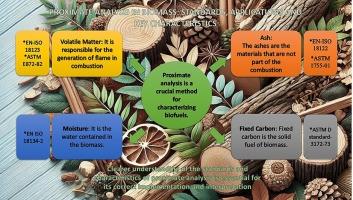Proximate analysis in biomass: Standards, applications and key characteristics
IF 2.5
Q2 CHEMISTRY, MULTIDISCIPLINARY
引用次数: 0
Abstract
Proximate analysis is a crucial method for characterizing biofuels, as it provides detailed information on moisture, volatile matter, ash, and fixed carbon content. This analysis is essential for evaluating the viability of biomass and optimizing its applications, particularly in renewable energy production. Understanding these parameters helps in comparing different biomass types and determining the best methods for their utilization or pretreatment to enhance efficiency. This study aims to address a gap in the literature by focusing specifically on biomass, in contrast to other fuels like coal and coke, which fall outside the scope of this research. A comprehensive literature review was conducted using the Web of Science database, with a focus on the standards, applications, and characteristics of proximate analysis as they pertain to biomass. The review was organized into four main categories: proximate analysis, volatiles, ash, and fixed carbon. While standards for proximate analysis are well-established for various materials, this study emphasizes the importance of specific protocols tailored to biomass to ensure accurate application. The findings suggest that a clearer understanding of the standards and characteristics of proximate analysis is essential for its accurate implementation and interpretation. This study addresses gaps in current practices and offers recommendations for future research.

生物质的近似分析:标准、应用和主要特征
生物量分析是鉴定生物燃料特性的重要方法,因为它能提供有关水分、挥发物、灰分和固定碳含量的详细信息。这种分析对于评估生物质的可行性和优化其应用至关重要,尤其是在可再生能源生产方面。了解这些参数有助于比较不同类型的生物质,并确定利用或预处理生物质的最佳方法,以提高效率。与煤炭和焦炭等其他燃料相比,生物质不属于本研究的范围,本研究旨在通过专门关注生物质来填补文献空白。本研究使用 Web of Science 数据库进行了全面的文献综述,重点关注生物质近似分析的标准、应用和特点。综述分为四大类:近似分析、挥发物、灰分和固定碳。虽然针对各种材料的近似物分析标准已经确立,但本研究强调了针对生物质制定具体方案以确保准确应用的重要性。研究结果表明,更清楚地了解近似分析的标准和特征对于准确实施和解释近似分析至关重要。本研究弥补了当前实践中的不足,并为今后的研究提出了建议。
本文章由计算机程序翻译,如有差异,请以英文原文为准。
求助全文
约1分钟内获得全文
求助全文

 求助内容:
求助内容: 应助结果提醒方式:
应助结果提醒方式:


